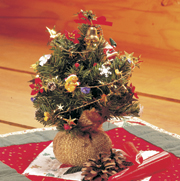Opening the Door to a Simpler, Greener,
Healthier, Happier Holiday Season
By Wendy Priesnitz
 Lost touch with the excitement you felt as a child at the approach of the holiday season? Dreading the relentless round of advertising, Santa Clause images, and worn out Christmas songs? Wondering how such a magical idea got so off track? Feeling like you want to do something different this year? Lost touch with the excitement you felt as a child at the approach of the holiday season? Dreading the relentless round of advertising, Santa Clause images, and worn out Christmas songs? Wondering how such a magical idea got so off track? Feeling like you want to do something different this year?
Here are some tips for simplifying the holiday season, whether it is a sacred or a secular occasion for you and your family. The trick is to engage in people-loving activities, which will revive your spirit rather than depress it. Focus on joy and humanity rather than on shopping.
Keep in mind that putting magic into holidays takes a flight of fancy, not a spending spree. Last year, the Center for a New American Dream found that more than half of all Americans (54 percent) feel that spending less money on gifts will actually allow them to focus more on the true meaning of the holidays, and nearly four out of five Americans surveyed (77 percent) said that they would like to have a more simplified holiday this year.
However, Christmas (and to some degree Hanukah) commercialization is so deeply ingrained in our society that changing it may not be easy. Patience and perseverance are required, along with some creativity. In the lead-up to the season, restrict exposure to the commercial propaganda by watching television less frequently and making fewer trips to malls. And think through every tradition associated with the holiday to find ways your family can make it simpler, healthier and less commercial.
Meaningful Giving
For many people, the joy of Christmas is lost in ceaseless bustle as they are consumed with doing, spending and getting, all at a frantic pace. Gift giving is not only the most commercial aspect of the season, it creates the most economic and environmental problems.
Rediscover creativity in gift giving, both in what you give and where you buy. Recover the almost lost art of self-giving through gifts of time and skill, as well as presents made in the kitchen, workshop or at the desk. A gift that you have made yourself is usually treasured far above a store-bought one, even if it is a bit rougher around the edges than its commercial counterpart. If you can’t sew, paint or cook (or don’t enjoy these activities), give a gift of your time or another skill that you possess...a certain number of babysitting hours for a new mom, a massage for a harried business executive, a monthly letter writing session for an arthritic elder, and so on.
Gift giving is not only the most commercial aspect of the season, it creates the most economic and environmental problems. So rediscover creativity in gift giving, both in what you give and where you buy.
If you must buy gifts, fair trade products are now readily available by mail order and in gift shops in most North American cities. Your first stop might be your local church or synagogue to see if they're planning to hold a fair trade sale day or alternative Christmas fair.
Consider giving a gift of life in someone’s honor to someone who is truly in need. If you want to spend money on gifts for your friends and family, give an equal amount to charity. Then write on the card something like: “This gift has been doubled by an equal gift given in your name to .......” Some people forego gift giving altogether, and replace it with charitable donations. Food, clothing and other forms of emergency assistance are always needed by social service agencies whose clients have unmet needs for food, clothing and shelter. There are also national and international agencies which specialize in providing relief to the poor and in war-torn areas.
Wrapping your gift in paper is wasteful of both trees and money, although it is possible to steam-iron and reuse gift-wrap. You could give your gifts unwrapped, but disguising your gift is fun and adds to the excitement. And giving a beautifully wrapped gift honors the recipient by communicating the care and thought involved in the acts of choosing, preparing and giving.
The Japanese give gifts wrapped in pretty scarves, which can be used for their intended purpose or kept to wrap up more presents. Little wicker baskets can also be re-used for gift wrapping, but it can be a problem storing them. Easier to store in a flat box or drawer are the little decorated plastic bags that many small items are now put into when bought. These can be decorated and tied with ribbon, and used again.
Or make the wrapping part of the gift. Wrap a gift of glassware in a tea towel, package an assortment of gardening tools and seeds in a wicker basket, a book in a tote bag, a bottle of wine in a wine cooler, a bread mix in a cooking pan, and so on.
Christmas cards are also wasteful of trees and money. They are also less personal than a letter, phone call or in-person greeting. Many people have curtailed or eliminated this often mindless tradition in recent years, but if you must give cards, buy them from charities like UNICEF or Oxfam, for whom they are a big source of income. Then make sure you reuse parts of the ones you receive in subsequent years for gift tags.
Decorating with Nature
There’s no need to spend money on decorations for your home, many of which will soon end up in the garbage. Objects that you find on walks, such as beautiful leaves, evergreen boughs, pinecones, nuts and branches with berries, can add a touch of holiday charm to your home. Of course, they won’t stay fresh for long, but who needs to extend the season artificially anyway? In many areas, mistletoe and holly are available either naturally or commercially. Make hanging ornaments from these natural items by adding ribbon or string them along with cranberries and popcorn to make garlands. Even a bowl of shiny green and red apples will look simply festive.
 And then there is the Christmas tree. If the mass-produced artificial ones don’t convey the holiday spirit for your family, consider a live tree. They are a great alternative to the ones that are chopped down from plantations and used for a few weeks over the Christmas period before being discarded. In many areas, an evergreen can be potted in the fall, brought inside for a few weeks over the holidays, then kept in a sheltered spot until it can be planted in the ground. And then there is the Christmas tree. If the mass-produced artificial ones don’t convey the holiday spirit for your family, consider a live tree. They are a great alternative to the ones that are chopped down from plantations and used for a few weeks over the Christmas period before being discarded. In many areas, an evergreen can be potted in the fall, brought inside for a few weeks over the holidays, then kept in a sheltered spot until it can be planted in the ground.
Depending on where you live, consider these varieties: Monteray or Radiata Pine (Pinus radiata), Dwarf White Spruce (Picea glauca ‘Conica’), Blue Spruce (Picea pungens ‘Kosteriana’), Blue Cedar (Cedrus atlantica ‘Glauca’), Nordmann Fir (Abies nordmanniana), Noble Fir (Abies nobilis ‘Glauca’), Scots Pine (Pinus sylvestris), Norway Spruce (Picea abies). Or consult your local nursery. Some other trees, which are often sold as houseplants, make good alternative Christmas trees, such as Norfolk Island Pine (Araucaria heterophylla). For those with allergies, the Norfolk Pine has the advantage of no scent.
For those who don’t mind a less traditional take on a tree but want something to decorate, the sky is the limit. Consider training ivy on a topiary form in a tree shape. Or shop the nurseries for potted holly plants or rosemary clipped into the shape of an evergreen tree.
My family used to trek out into the woods and bring home a fallen deciduous branch. We made sure it had lots of sturdy small branches strong enough to hold ornaments, stood it on regular Christmas tree stand, and enjoyed decking it out with hundreds of hand-made and hand-me-down decorations.
People Activities
So many holiday activities involve either spending money, partying with people you wouldn’t choose to be with at other times of the year, or drinking and eating too much. As an alternative or at least as an antidote, spend time in nature, preferably with your family. Nature reminds us of our place in the world, fills us with a wonder appropriate to the season and helps restore our souls – and it's free. So take a family walk, organize a sledding party or hold a marshmallow roast. If it’s too cold to be outside, spend family time indoors, sometimes by candlelight (beeswax, of course). Eat and/or read stories by candlelight as often as you can during the holidays.
Another family activity that will help everyone get into the spirit of the season is a family service project, such as working together at a soup kitchen or sorting donations at a food bank.
Celebrate the Solstice
For those of us in the northern hemisphere who don’t follow the Christian religion – or who are just burnt out with the commercial of Christmas – the winter solstice provides an alternative focus for holiday celebrations. Traditionally a celebration of the cycle of nature and a reaffirmation of the continuation of life, the solstice marks the return of the sun after the longest night in the year.
Many of the ancient traditions surrounding Christmas are concerned with coping with the darkness and the evils it was thought to harbor, and helping the return of light and warmth. Take holly, for instance. Evergreens were cherished at this time of year as a natural symbol of rebirth and life amid winter whiteness. But holly was particularly prized to decorate doors, windows and fireplaces because of its prickliness – to either ward off or snag and capture evil spirits before they could enter and harm a household. Candles, fireplaces, meditations or prayers and the sharing of good food seem to be the focus for many winter solstice celebrations.
As the Grinch found, celebrating the season in style doesn’t take tinsel and trappings. Lights, a little food, some music, and a family to do it all with (instead of just watching people on TV do things), and you have an alternative Christmas celebration.
For more detail on these topics, check out more green Christmas articles from Natural Life Magazine.
Wendy Priesnitz is Natural Life Magazine's editor, a journalist with over 40 years of experience, and the author of 13 books.
|

